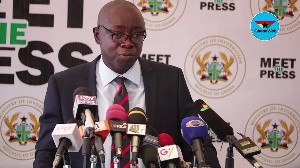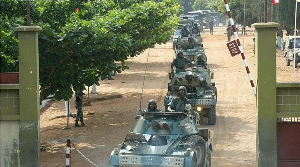The Ministry of Lands and Natural Resources in collaboration with the Minerals Commission is reviewing the existing laws governing minerals and mining in the country in order to add nine more products, goods and services to enhance the capacity of all mining companies.
The decision to change Act 2012 (LI.2173) forms part of government’s effort to promote local content in the mining industry, particularly in the manufacturing and service sectors, aimed at creating employment in country.
The sector Minister, Mr. Kwaku Asomah-Cheremeh, disclosed this when he took his turn at the ‘’Meet the Press’’ series in Accra.
The rationale behind the addition to the Local Procurement List for the mining industry is to ensure that goods and services, which are locally made, are available in adequate quantities and at an optimal price, aside meeting the appropriate safety and quality standards, he explained.
The Minster mentioned the list as follows: Security Services (Exclusive Ghanaian Directors and Shareholders), Legal Services (Exclusive Ghanaians), Insurance Services (Strictly incorporated in Ghana) and Financial Services (Strictly incorporated in Ghana).
The rest are, Contract Mining (Strictly incorporated in Ghana), Fuel (Exclusive Ghanaian Directors and Shareholders), Activated Carbon, Cable Bolt and Accessories, Split Setts, Rebars, Mining Mesh and Cupels.
To further enhance the work of the Minerals Commission, the Minister noted that, some measures have been taken to restructure the Commission by streamlining small scale mining activities.
Furthermore, the Commission has also undergone some institutional reforms, to facilitate Government efforts in the establishment of additional Regional, District and Satellite offices of the Commission to enhance visibility and monitoring of small scale mining activities.
Touching on the contribution of the Mining Sub-Sector, the Minister said, the sector contributed GH¢ 2.2 billion to Government revenue, representing 16.3% of total domestic tax to the Economy in 2017.
“For the first half of 2018, the Mining Sub-Sector contributed a total revenue of GH¢1.03 billion to Government in the form of Domestic Tax. This is an increase of 17.11per cent as compared to the GH¢ 877 million collected in the first half of 2017,” he said.
Again, the sector contributed 7.2 per cent to Gross Domestic Product (GDP) in 2017 compared to 8.0 per cent GDP in 2016. This means the sector contributed GH¢17.1 billion to the Ghanaian economy in 2017 compared to GH¢15.8 billion in 2016.
Furthermore, the sector contributed 44 per cent of total merchandise exports in 2017 translating into US$6 billion compared to US$ 5 billion in 2016 representing 45 per cent.
For the first half of this year, Ghana earned US$ 3.1 billion from minerals’ export representing 38 per cent of Total Merchandize Export.
He also revealed that Investments in the Mining Sub-Sector had increased to seven per cent in 2016 which showed an increase from US$ 970 million in 2016 to US$ 1.04 billion in 2017.
According to him, the increase in revenues accruing from the sector is as a result of increase in production of the traditional minerals coupled with favourable metal price on the international commodities market.
He said bauxite production increased by 16 per cent in 2017 to 1.5 million metric tonnes compared to 1.3 million metric tonnes in 2016. Manganese production saw an increase to 3 million metric tonnes in 2017 representing an increase of 49% over 2016 production.
Gold production, however, witnessed a marginal dip from 4.24 million ounces in 2016 to 4.23 million ounces in 2017.
For 2018, all minerals except bauxite witnessed significant increase in production during the first half as compared to 2017. Bauxite decreased by 167 thousand metric tonnes in the first half of 2018 as compared to the same period in 2017. A total of 537 thousand metric tonnes was produced in first half 2018 as compared to 703 thousand metric tonnes in first half 2017.
‘’This represents a decrease of 23.69%. Manganese production however continued in the trajectory of growth. The country produced 1.9 million metric tonnes of manganese in the first half of 2018 as compared to 1.3 million metric tonnes in the first half of 2017. This resulted in an increase of about 44 per cent over the period,’’ he said.
Gold, which is Ghana’s flagship mineral, saw production rise from 2.2 million ounces in first half of 2017 to 2. 5 million ounces in first half of 2018 representing an increase of 13.67%.
On Illegal mining, the Minister said despite all the contributions stated above, the mining sector has seen its fair share of challenges. The most prominent among them are challenges posed by illegal mining activities and its associated environmental implications.
To address this challenge, a moratorium to temporarily suspend artisanal and small-scale mining operations was put in place in April, 2017. The main objectives of the ban are to reduce uncontrolled pollution of water bodies’ Degradation of forest and farmlands, and Illegal small-scale mining activities.
Business News of Friday, 7 December 2018
Source: classfmonline.com

















